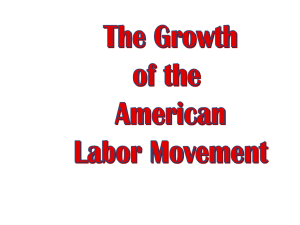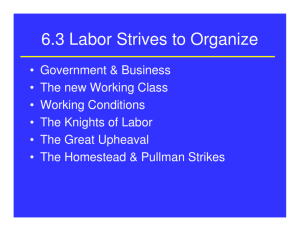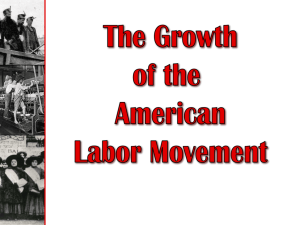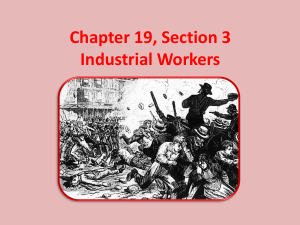Labor Movement
advertisement
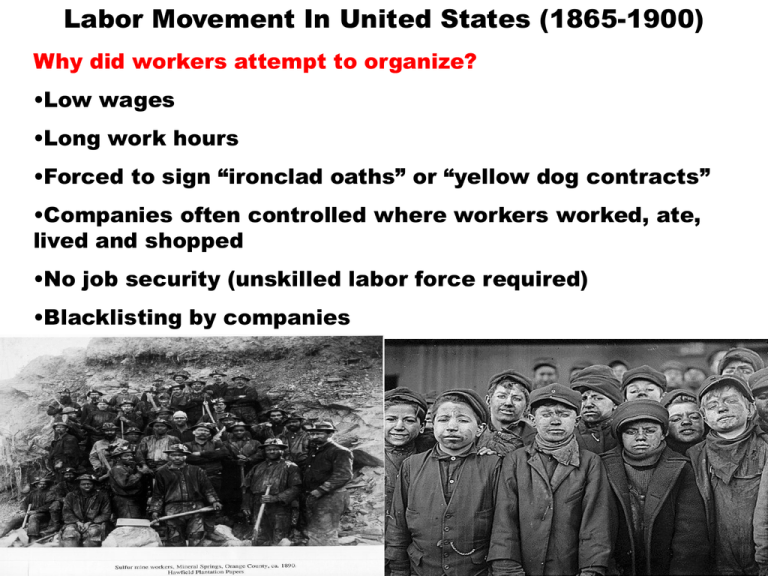
Labor Movement In United States (1865-1900) Why did workers attempt to organize? •Low wages •Long work hours •Forced to sign “ironclad oaths” or “yellow dog contracts” •Companies often controlled where workers worked, ate, lived and shopped •No job security (unskilled labor force required) •Blacklisting by companies Labor Force Distribution 1870-1900 The Changing of American Labor Force Child Labor in the US “Galley Labor” Labor Unrest (1870-1900) Management v . Labor “Tools” of management •“scabs” •P. R. campaign •Pinkertons •Lockout •Blacklisting •yellow-dog contracts •court injunctions •open shop “Tools” of labor •Boycotts •sympathy demonstrations •informational picketing •closed shops •organized strikes •“wildcat” strikes •collective bargaining Workers organize! National Labor Union (NLU) •Organized in 1866 by William Sylvis •Lasted 6 years •Focused on 8 hour workday, collective bargaining •Included skilled and unskilled workers, farmers and blacks (until 1869) •Destroyed by depressions of 1870s. Knights of Labor (1869) •Founded by Terence Powderly •“One Big Union” including women and blacks •Fought for many social and economic reforms •Destroyed by the Great Upheaval and Haymarket Square Riot Goals of Knights of Labor: •8 hour workday •Safety codes •End of child labor •End of wage system •Equal pay for women •Higher pay •Gov’t regulation of industry “An injury to one is concern to all…” •The Knights destroyed by the Great Upheaval (1886) and especially the Haymarket Square Riot (May 4, 1886) Haymarket Square Riot •Five anarchists sentenced to death and three others given stiff prison sentences • Knights of Labor were blamed •In 1892, Governor Altgeld pardoned the remaining three Other notable action by organized labor Great Railroad Strike of 1877 •First nationwide strike •Over 100,000 workers involved, 14 states affected, and 10 railroads •President Hayes dispatched federal troops to stop the strike (important!) Molly Maguires (1875) •Radical organization (all Irish) •Secret organization (Ancient Order of Hiberians) •Used violence, murder, arson, threat to fight for the right to unionize •Infiltrated by Pinkertons •Twenty members hanged and organization destroyed in 1877 James McParland American Federation of Labor (1886) •Created by Samuel Gompers Different approach of the AFofL: •Concentrated only on skilled labor •Dealt only with “bread and butter” issues •Enforced closed shop •Maintained strike fund •500,000 members by 1900 (Labor Trust?) •Walkout and boycott as instruments of labor •Attempted to be non-political Homestead Strike (1892) •One of Carnegie’s steel plants •Started after workers’ salaries slashed by 20% by Carnegie and Frick •300 Pinkertons were defeated by the workers •PA governor called in 8,000 militia, scabs replaced workers •Union broken •Clearly showed that employer can break a strike using private police with support of gov’t and courts Attempted assassination of Henry Frick The Amalgamated Association of Iron & Steel Workers destroyed… Henry Clay Frick Alexander Berkman Pullman Strike (1894) •Pullman Town built as a response to Railroad Strike of 1877 •Pullman hit by depression cuts wages by 1/3, prices of rent remaining the same •Eugene V. Debs involved in the strike although warned ARU (American Railway Union) not to strike •Pullman cars destroyed, traffic from Chicago to the Pacific stopped •Grover Cleveland calls in troops after an injunction is issued by the court claiming mail is not delivered. •First time a strike is stopped by injunction (AUR destroyed) •Government by injunction! “If it takes the entire army and navy to deliver a postal card in Chicago, that card will be delivered!” Eugene V. Debs becomes the leader of the Socialist Party after being released from prison… •Ran for President in 1904, 1908, 1912, and 1920 (last time from prison) Industrial Workers of the World (Wobblies) (1905) Bill Haywood “Violence was justified to overthrow capitalism” •Ag. AFofL strategy •Socialism = the answer •Mostly destroyed by gov’t for the radical stance and opposition to WWI The Hand that will rule the World=One Big Union “The working class and the employing class have nothing in common. There can be no peace so long as hunger and want are found among millions of the working people and the few, who make up the employing class, have all the good things of life. Between these two classes a struggle must go on until the workers of the world organize as a class, take possession of the means of production, abolish the wage system, and live in harmony with the Earth. ... Instead of the conservative motto, 'A fair day's wage for a fair day's work', we must inscribe on our banner the revolutionary watchword, 'Abolition of the wage system.' It is the historic mission of the working class to do away with capitalism… “ The formula unions + violence + strikes + socialists + immigrants = anarchists “Solidarity Forever!” by Ralph Chapin (1915) When the union's inspiration through the workers‘ blood shall run, There can be no power greater anywhere beneath the sun; Yet what force on earth is weaker than the feeble strength of one, But the union makes us strong! CHORUS: Solidarity forever, Solidarity forever, Solidarity forever, For the union makes us strong! Impact of Labor Unions •23,000 strikes involving 6.6 million workers (1881-1900) •Labor Day instituted by Congress in 1894 •Public slowly began to support labor unions •AFofL reaches 3 million members in 1917 •Some union accomplishments stopped by courts (Lochner v. New York (1905), Danbury Hatters Case, 1908) •Wide use of injunction by the courts under the Sherman Anti-Trust Act Right to Work States Today
